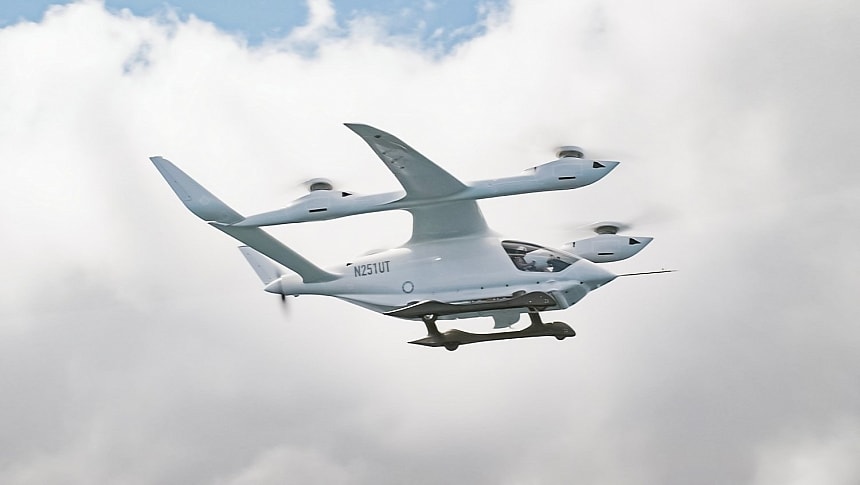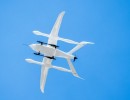If you're an aviation enthusiast, particularly when it comes to the new-generation eVTOLs (electric vertical takeoff and landing), this video of the Alia-250 will probably give you goosebumps. It's a highly rewarding achievement for the Vermont-based team and another milestone for the AAM (Advanced Air Mobility) industry.
Transitions are the very essence of eVTOLs, the "magical points" when these aircraft go from flying like a helicopter to flying like an airplane and vice versa. An eVTOL concept can only be considered fully viable when it's capable of completing these transitions smoothly, safely, and effectively. This is where most of the unique power of an eVTOL comes from: it's meant to combine the benefits of helicopters with those of airplanes, with the added bonus of zero-emission propulsion.
This is why achieving full transition is one of the key moments for any eVTOL, and the Alia-250 successfully passed the test. Beta Technologies released footage of its dragonfly-shaped aircraft flying like a helicopter (hover), transitioning to airplane-like cruising (wing-borne flight), and then switching back to flying like a helicopter before landing safely.
The Alia aircraft's lift-plus-cruise configuration and the fact that this was a manned flight made this milestone even more special for the industry as a whole.
Beta's Alia will be available in two versions, an eVTOL and an eCTOL (fixed-wing electrical conventional takeoff and landing), which is identical to the eVTOL except for the lifting propellers that ensure vertical flight. Since there was no transition involved, the Alia eCTOL was able to carry out several demonstration flights prior to this milestone, including an international trip.
The eCTOL version will also be able to obtain type certification earlier, most likely next year, while the Alia-250 eVTOL is expected to reach certification by 2026.
The Alia eCTOL was also the first green aircraft officially selected by Air New Zealand as part of its Mission Next Gen Aircraft program. The Kiwi airline wants to replace its conventional Q300 turboprops with a fleet of new-generation, low-emission aircraft by the end of this decade. After an 18-month-long evaluation, it eventually selected the Vermont-based company and the eCTOL version of the Alia-250.
This aircraft is designed to fly at 270 kph (167.7 mph) and cover more than 480 km (298 miles) in one take (the ones operated by Air New Zealand will only be used for short trips of no more than 150 km/93 miles).
In addition to these two equally impressive versions of the Alia aircraft, Beta Technologies is also one of the few manufacturers in this young industry to focus on charging infrastructure. Its Charge Cube was recently certified, and the company is slowly building a nationwide network of agnostic, multi-modal chargers for both aircraft and EVs at airports.
This is why achieving full transition is one of the key moments for any eVTOL, and the Alia-250 successfully passed the test. Beta Technologies released footage of its dragonfly-shaped aircraft flying like a helicopter (hover), transitioning to airplane-like cruising (wing-borne flight), and then switching back to flying like a helicopter before landing safely.
The Alia aircraft's lift-plus-cruise configuration and the fact that this was a manned flight made this milestone even more special for the industry as a whole.
Beta's Alia will be available in two versions, an eVTOL and an eCTOL (fixed-wing electrical conventional takeoff and landing), which is identical to the eVTOL except for the lifting propellers that ensure vertical flight. Since there was no transition involved, the Alia eCTOL was able to carry out several demonstration flights prior to this milestone, including an international trip.
The eCTOL version will also be able to obtain type certification earlier, most likely next year, while the Alia-250 eVTOL is expected to reach certification by 2026.
The Alia eCTOL was also the first green aircraft officially selected by Air New Zealand as part of its Mission Next Gen Aircraft program. The Kiwi airline wants to replace its conventional Q300 turboprops with a fleet of new-generation, low-emission aircraft by the end of this decade. After an 18-month-long evaluation, it eventually selected the Vermont-based company and the eCTOL version of the Alia-250.
This aircraft is designed to fly at 270 kph (167.7 mph) and cover more than 480 km (298 miles) in one take (the ones operated by Air New Zealand will only be used for short trips of no more than 150 km/93 miles).
In addition to these two equally impressive versions of the Alia aircraft, Beta Technologies is also one of the few manufacturers in this young industry to focus on charging infrastructure. Its Charge Cube was recently certified, and the company is slowly building a nationwide network of agnostic, multi-modal chargers for both aircraft and EVs at airports.









